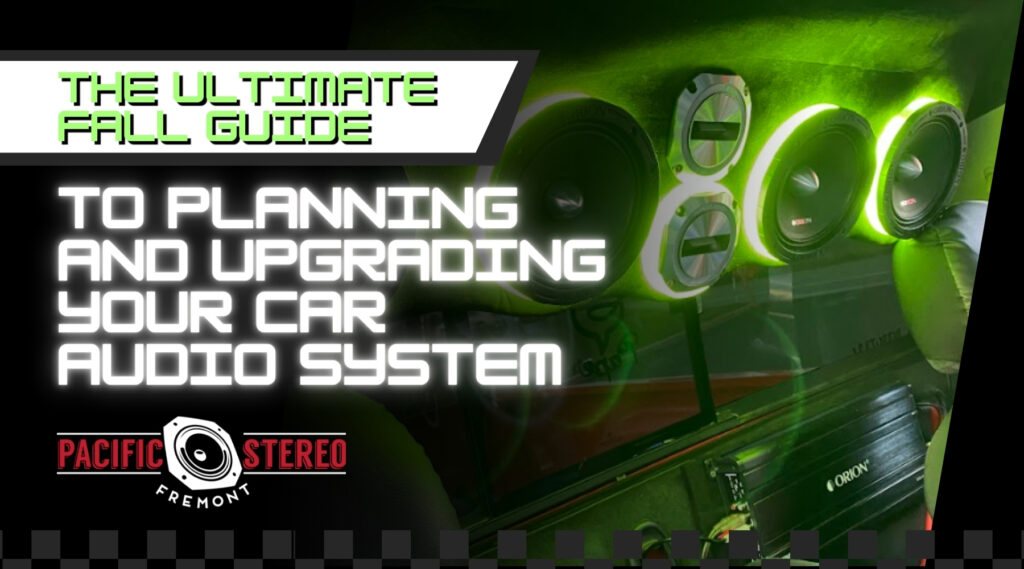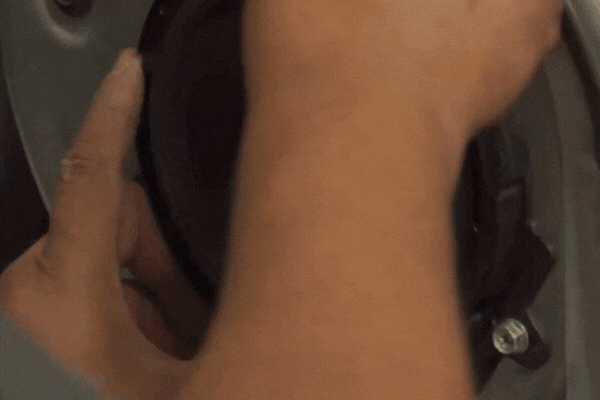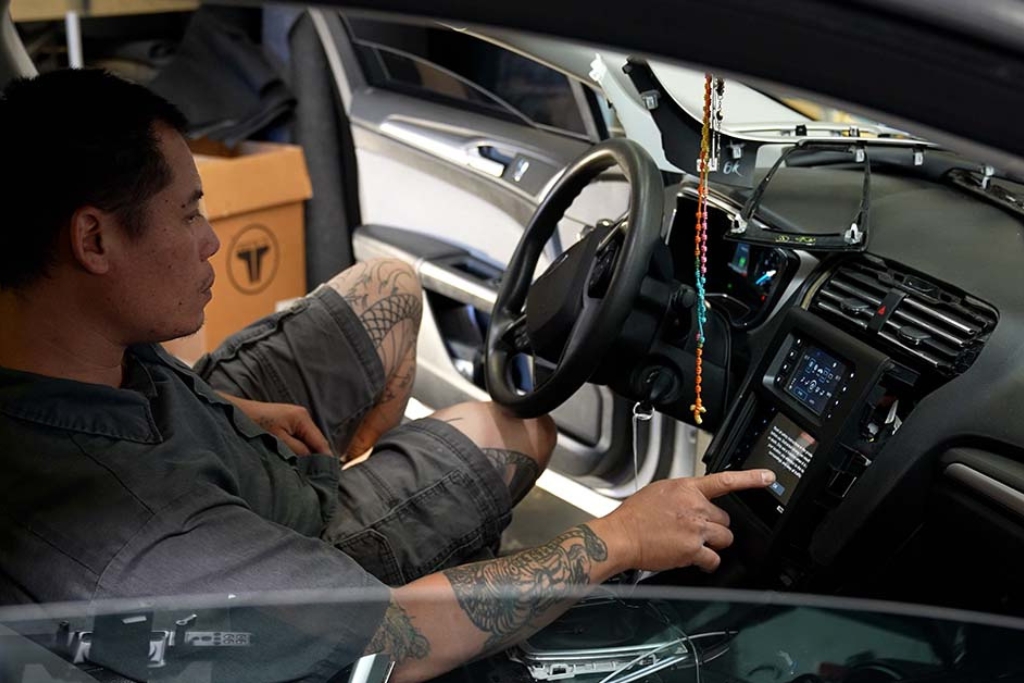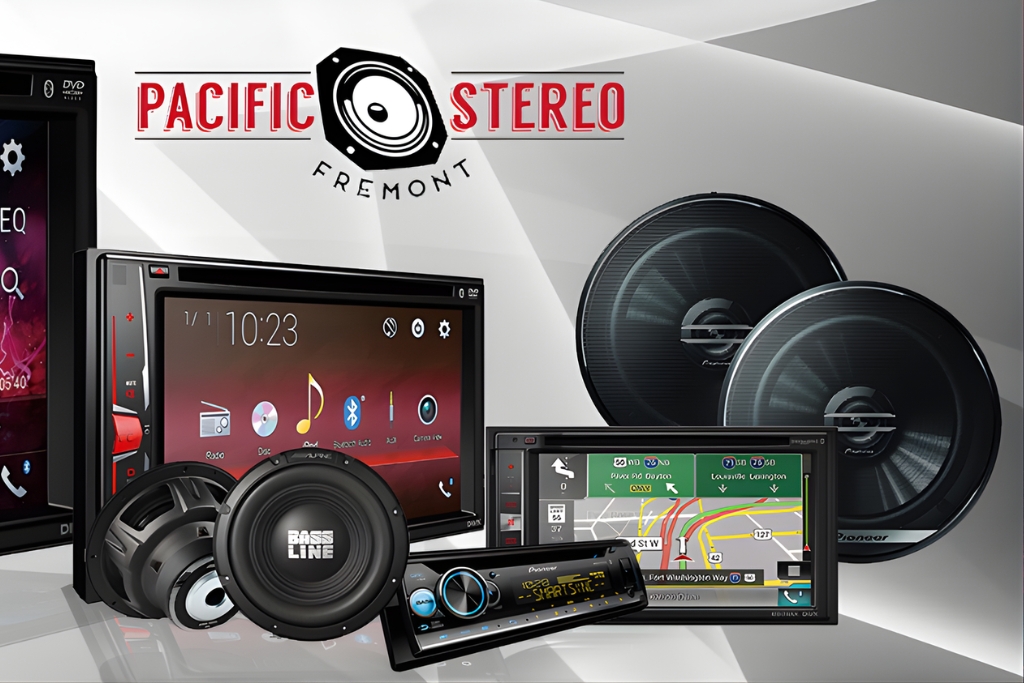
Why Fall Is the Ideal Season for a Car Audio Upgrade

Why Factory Car Stereos Often Fall Short
Why Planning Your Upgrade Is Crucial
Jumping into a car audio project without a plan often leads to mismatched components and wasted money. A thoughtful approach helps you balance performance, aesthetics, and budget, something Pacific Stereo Fremont specializes in.
Step 1: Define Your Goals & Budget

What Order Should You Upgrade Car Audio?
Start with what will make the biggest impact:
- Speakers – The most noticeable sound improvement.
- Head Unit – Enables features like touchscreen controls, Android Auto, and higher audio quality.
- Amplifier – Enhances volume and clarity.
- Subwoofer – Adds the bass that the factory systems lack.
- Tuning and Wiring – The secret to premium performance.
Set Your Priorities
Ask yourself:
- Do I want louder, clearer sound?
- Do I need smartphone integration?
- What’s my budget?
Step 2: Choose the Right Aftermarket Car Audio Components

Head Unit Replacement Tips
Your head unit is the control center of your system. Look for features like:
- Touchscreen display
- Apple CarPlay & Android Auto
- Bluetooth streaming
- USB/HDMI inputs for modern connectivity
Use a factory wiring harness adapter to prevent damage to your car’s electronics during the upgrade.
Choosing Car Audio Speakers
When comparing coaxial vs component speakers, remember:
- Coaxial: All-in-one (easier to install).
- Component: Separate tweeter and woofer for better clarity.
Focus on:
- RMS power rating (match this with your amp)
- Speaker sensitivity rating (higher sensitivity = louder sound at lower power)
Amplifier Channel Configurations
An amplifier boosts power and sound clarity. Consider:
- 2-channel: Good for front speakers
- 4-channel: Front and rear coverage
- Mono: Ideal for subwoofers
Installing a Subwoofer in Your Car
Adding a sub transforms your experience, bass you can feel. Choose between:
- Sealed enclosures – Tight, accurate bass
- Ported enclosures – Louder, boomier bass
Car Audio Wiring and Power Requirements
Power matters. Upgrading cables, grounds, and distribution blocks ensures safety and performance.
What Is the Big 3 Upgrade?
This involves upgrading:
- Battery-to-chassis ground
- Engine block-to-chassis ground
- Alternator-to-battery wire
This reduces resistance and improves electrical flow for high-performance audio setups.
Digital Signal Processor (DSP) & Tuning
For true audio fidelity, a DSP lets you shape frequencies, time-align your speakers, and compensate for your car’s unique acoustics. At Pacific Stereo, every system includes car audio tuning and calibration for optimal performance.
Sound Deadening Material
Adding sound deadening keeps your music in and road noise out. It’s essential for maximizing speaker output and clarity.
Step 3: The Installation Process

Upgrading your car audio isn’t just about plugging in new gear; it’s about doing it right. Here’s what a professional car audio system installation process typically includes:
Disconnect the Battery
Remove Factory Equipment
Install New Gear
The fun part! Technicians mount your new head unit, install aftermarket speakers in factory or custom locations, place your amplifier in a well-ventilated space, and secure the subwoofer with the appropriate enclosure type (sealed or ported).
Wire Everything Correctly
Proper wiring ensures clean sound and long-term reliability. This includes running new power cables, using a factory wiring harness adapter, ensuring a solid ground connection, and organizing wires to avoid interference.
Test the System Thoroughly
Final Reassembly and Cleanup
Choosing professionals like Pacific Stereo Fremont ensures a clean, precise installation, no wire messes, no rattles, and no guesswork. You’ll leave with a sound system that looks and performs like it came from the factory, only better.
Step 4: Optimize Your System for Fall Travel

Once your upgraded system is installed, a few seasonal adjustments can make a big difference, especially as you gear up for holiday road trips and cooler weather.
Inspect Wiring and Ground Points
Temperature drops can cause materials to contract, loosening connections over time. Check all wiring, especially power and ground points, for secure contact and signs of wear or corrosion.
Tune for Cold Weather Acoustics
Cooler air can slightly alter the behavior of sound waves inside your cabin. A quick tuning session, adjusting equalizer settings or time alignment, can help maintain balance and clarity.
Optimize Audio Files
Streaming services compress audio, which can limit your system’s potential. Use high-bitrate MP3s, FLAC files, or high-resolution streaming options to fully enjoy your system’s capabilities.
Check DSP Settings
If your setup includes a digital signal processor (DSP), revisit its settings to account for seasonal driving changes, such as passenger loads, window positions, or different road surfaces.
Keep it Clean
Fall can bring dust and debris into your car. Regularly clean speaker grilles and subwoofer enclosures to avoid buildup that might muffle sound.
Fine-tuning these small details ensures your car audio system delivers peak performance, whether you’re cruising through Fremont or heading out for a weekend getaway.
Best Car Audio Upgrades for 2025

Technology in car audio is evolving fast, and 2025 is all about smarter, cleaner, and more integrated systems. Here are the top upgrades worth considering:
Wireless CarPlay & Android Auto Head Units
Ditch the cords and enjoy seamless phone integration for music, navigation, and voice commands. Look for models with fast processors and vibrant touchscreens for a smoother user experience.
Smart Amplifiers with Built-In DSP
These modern amps combine power with precision tuning. Built-in digital signal processors (DSPs) enable real-time sound adjustments without additional components, saving space and simplifying installation.
Custom Subwoofer Enclosures
Tailored enclosures are designed to fit your vehicle perfectly while enhancing bass output. They not only sound better but also blend aesthetically with your car’s interior.
Compact Under-Seat Subwoofers
Ideal for smaller vehicles or clean builds, these subs pack an impressive punch without taking up trunk space, a smart solution for daily drivers.
App-Controlled Tuning Systems
Fine-tune your audio settings via smartphone apps. Adjust EQ, time alignment, and crossover settings on the fly, no tools or laptops required.
Not sure which upgrades are right for your vehicle or budget? Get a free estimate from the team at Pacific Stereo Fremont. We’ll help you build the perfect system for 2025 and beyond.
Start Your Fall Upgrade at Pacific Stereo Fremont
Planning and upgrading your car audio system this fall is a rewarding way to elevate your driving experience. Whether you’re after booming bass, smart connectivity, or crisp vocals, Pacific Stereo Fremont has the expertise, brands, and craftsmanship to make it happen.
Ready to transform your ride? Visit Pacific Stereo Fremont or get your free estimate, and let’s make your fall drive sound amazing.
Frequently Asked Questions (FAQ)
Is Upgrading Car Speakers Worth It?
Absolutely. Aftermarket speakers deliver significantly better clarity and frequency response than factory models.
What's the First Step in a Car Audio Upgrade?
Upgrade your speakers first; it offers the biggest improvement for the cost.
Why Add an Amplifier?
Amps provide clean, undistorted power, especially at high volumes.
How Does a Subwoofer Improve Sound?
It fills in low-end frequencies that factory systems can’t reach, delivering a richer, fuller sound.
Why Match Amplifier and Speaker RMS?
Matching the RMS power rating ensures safe and optimal performance. Overpowering or underpowering can damage components.
What's the Big 3 Upgrade?
It improves electrical flow for systems with high power demands, enhancing both performance and safety.
Pacific Stereo Fremont
address
40955 Albrae St, Fremont, CA 94538, United States
address
+1 510-656-6677
Open hours
Sunday Closed
Monday to Saturday 9 AM–6:30 PM


